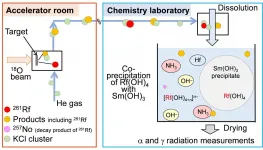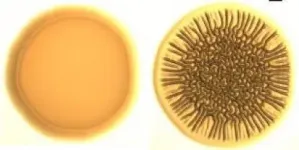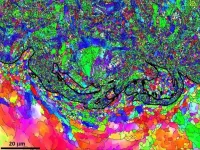The smallest galaxies in our universe bring more about dark matter to light
2021-02-16
(Press-News.org) Our universe is dominated by a mysterious matter known as dark matter. Its name comes from the fact that dark matter does not absorb, reflect or emit electromagnetic radiation, making it difficult to detect.
Now, a team of researchers has investigated the strength of dark matter scattered across the smallest galaxies in the universe using stellar kinematics.
"We discovered that the strength of dark matter is quite small, suggesting that dark matter does not easily scatter together," said professor Kohei Hayashi, lead author of the study.
Much is unknown about dark matter, but theoretical and experimental research, from particle physics to astronomy, are elucidating more about it little by little.
One prominent theory surrounding dark matter is the "self-interacting dark matter (SIDM) theory." It purports that dark matter distributions in galactic centers become less dense because of the self-scattering of dark matter.
However, supernova explosions, which occur toward the end of a massive star's life, can also form less dense distributions. This makes it challenging to distinguish whether it is the supernova explosion or the nature of dark matter that causes a less dense distribution of dark matter.
To clarify this, Hayashi and his team focused on ultra-faint dwarf galaxies. Here a few stars exist, rendering the influences of supernova explosions negligible.
Their findings showed that dark matter is dense at the center of the galaxy, challenging the basic premise of SIDM. Images from the dwarf galaxy Segue 1 revealed high dark matter density at the center of the galaxy, and that scattering is limited.
"Our study showed how useful stellar kinematics in ultra-faint dwarf galaxies are for testing existing theories on dark matter," noted Hayashi. "Further observations using next-generation wide-field spectroscopic surveys with the Subaru Prime Focus Spectrograph, will maximize the chance of obtaining dark matter's smoking gun."
INFORMATION:
[Attachments] See images for this press release:

ELSE PRESS RELEASES FROM THIS DATE:
2021-02-16
Researchers from the Oil and Gas Research Institute of the Russian Academy of Sciences and their Skoltech colleagues have surveyed the newest known 30-meter deep gas blowout crater on the Yamal Peninsula, which formed in the summer of 2020. The paper was published in the journal Geosciences.
Giant craters in the Russian Arctic, thought to be the remnants of powerful gas blowouts, first attracted worldwide attention in 2014, when the 20 to 40-meter wide Yamal Crater was found quite close to the Bovanenkovo gas field. The prevailing hypothesis is that these craters are formed after gas is accumulated in cavities in the upper layers of permafrost, and ...
2021-02-16
In recent time, HBO's highly acclaimed and award-winning miniseries Chernobyl highlighted the horror of nuclear power plant accident, which happened in Ukraine in 1986. It is not a fictional series just on TV. As we had seen such a catastrophic nuclear power plant accident in 2011 again caused by natural disaster, Tsunami, in Japan. Both historical nuclear power plant accidents released tons of radioactive cesium to the environment. Consequently, the radioactive cesium found their way to the surrounding land, river, into the plants and animal feed, and eventually to our food cycle and ecosystem. The more detrimental part is their half-life, ...
2021-02-16
Both Earth and Mars currently have oxidising atmospheres, which is why iron-rich materials in daily life develop rust (a common name for iron oxide) during the oxidation reaction of iron and oxygen. The Earth has had an oxidising atmosphere for approximately two and a half billion years, but before that, the atmosphere of this planet was reducing - there was no rust.
The transition from a reduced planet to an oxidised planet is referred to as the Great Oxidation Event or GOE. This transition was a central part of our planet's evolution, and fundamentally linked to the evolution of life here - specifically ...
2021-02-16
Osaka, Japan - All chemistry students are taught about the periodic table, an organization of the elements that helps you identify and predict trends in their properties. For example, science fiction writers sometimes describe life based on the element silicon because it is in the same column in the periodic table as carbon.
However, there are deviations from expected periodic trends. For example, lead and tin are in the same column in the periodic table and thus should have similar properties. However, whilst lead-acid batteries are common in cars, tin-acid batteries don't work. Nowadays ...
2021-02-16
ST. LOUIS, MO, February 16, 2021 - Delivering the benefits of agricultural biotechnology to smallholder farmers requires that resources be directed toward staple food crops. To achieve effect at scale, beneficial traits must be integrated into multiple, elite farmer-preferred varieties with relevance across geographical regions. For the first time, an international team of scientists, led by Narayanan Narayanan, Ph.D., senior research scientist, and Nigel Taylor, Ph.D., associate member and Dorothy J. King Distinguished Investigator at the Donald Danforth Plant Science Center, and their collaborators in Nigeria, led ...
2021-02-16
For the first time, a research team led by Lund University in Sweden has mapped out exactly what happens when spruce bark beetles use their sense of smell to find trees and partners to reproduce with. The hope is that the results will lead to better pest control and protection of the forest in the future.
The Eurasian spruce bark beetle uses its sense of smell to locate trees and partners. The odours are captured via odorant receptors (proteins) in their antennae. Researchers have long understood the connection, but so far they have not known exactly which receptors bind to what pheromones. ...
2021-02-16
Scientists have discovered an essential protein in cholera-causing bacteria that allows them to adapt to changes in temperature, according to a study published today in eLife.
The protein, BipA, is conserved across bacterial species, which suggests it could hold the key to how other types of bacteria change their biology and growth to survive at suboptimal temperatures.
Vibrio cholerae (V. cholerae) is the bacteria responsible for the severe diarrhoeal disease cholera. As with other species, V. cholerae forms biofilms - communities of bacteria enclosed in a structure made up of sugars and proteins - to protect against predators and stress conditions. V. cholerae forms these biofilms both in their aquatic environment and in the human intestine. There is evidence to suggest that biofilm ...
2021-02-16
An international team of researchers has solved a puzzling phenomenon whereby strangely beautiful, vortex-like structures appear between materials deposited onto engineering components used in multiple settings - from space shuttles to household items and everyday transport vehicles.
The discovery may ultimately improve the efficiency of the "Cold Spray" (CS) deposition process from which these structures are formed - a not-insignificant consideration from a financial perspective, or from a functional one given that some of the materials created by CS are pushed to the limit in outer space.
The discovery is featured on the front cover of international journal, Materials & Design.
Cold Spray (CS) and deposition efficiency (DE)
CS enables the formation of coatings, ...
2021-02-16
Why do genes need to be silenced? The "genes" in question are in fact transposons, selfish genetic elements that seek to self-multiply at the host's expense and that need to be controlled. Julius Brennecke's group at IMBA focuses on lifting the mysteries of a specific type of transposon silencing, namely the piRNA pathway in animal gonads. Understanding this ancient silencing system promises to reveal general mechanistic principles of gene expression and chromatin biology.
Gene silencing: either before they "speak", or right as they attempt to
Heterochromatin, a tightly packed form of DNA, plays an essential role in transposon ...
2021-02-16
Many steep valleys in the European Alps show the relicts of large rockslides, during which several hundreds of million cubic metres of rocks get instable, collapse and impact everything on their path. "For most of these, we still do not know how they are caused, because these rockslides occurred long before the start of written history in the region about 1000 years ago," says Patrick Oswald, PhD student at the Department of Geology of the University of Innsbruck and lead author of the study. "Curiously, many of these ancient rockslides occurred together in clusters, meaning they are found in small regions and have a rather comparable age". This enigmatic pattern has puzzled researchers over the last decades and fuelled some intense debates. Some experts ...
LAST 30 PRESS RELEASES:
[Press-News.org] The smallest galaxies in our universe bring more about dark matter to light








